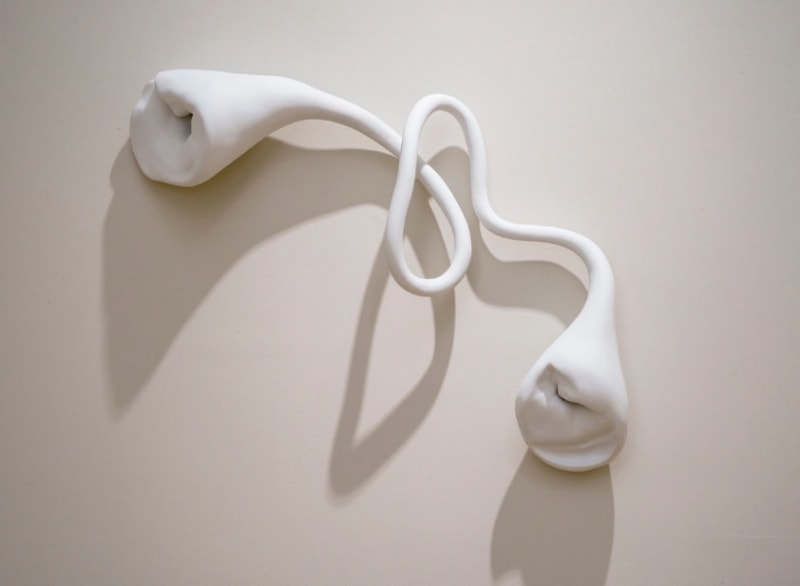
Alwar Balasubramaniam, Hold Nothing
Crack, weave, pulse — many other verbs could be added to the three in the main title of the Phillips Collection’s “Pour, Tear, Carve: Material Possibilities in the Collection.” The name refers to the 69-artist exhibition’s embrace of works that are not limited to paint on canvas. But the show also demonstrates the museum’s growing interest in art that’s local, contemporary and socially engaged.
Drawn entirely from the Phillips’s holdings and promised gifts, “Pour, Tear, Carve” spotlights new acquisitions, some of which came into the collection as the result of recent shows. Yet it includes a few pieces the gallery has long owned.
The earliest is Albert Pinkham Ryder’s “Moonlit Cove,” a darkly moody 1880 landscape the museum acquired in 1924. It’s one of only five oil paintings in the 74-object show, and was included because Ryder’s unconventional technique resulted in extensive cracking of the pigment. Georges Braque’s 1929 “The Round Table,” a cubist still life, is also an oil, but one in which sand was distinctively worked into the paint.
Among the newer acquisitions are several that would have fit comfortably into the collection decades ago, although most are of recent vintage. These include three by local female artists who extrapolate painting into sculpture: Mimi Herbert, Jae Ko and the late Anne Truitt. Herbert’s 2021 “Butterfly” is a slab of yellow acrylic, elegantly folded like a blanket, while Truitt’s circa-1969 “Moon Wind Object” is a rectangular wooden pylon, painted white with a stripe of exceedingly pale yellow that stretches around one corner. Much brighter is Ko’s untitled 2012 piece, a large roll of paper glued into a permanent twist and rendered red with calligraphic ink so that it suggests the brushstroke of a traditional East Asian artist.
Less sculptural, but with a robust physical presence, is Richard Serra’s 1991 “Reykjavik,” two tracts of thick black pigment on paper, applied by Paintstik — a crayon-like marker. The piece refers to the sculptor’s installation of nine pillars in Iceland. Its heavy dark forms contrast with the delicacy of A. Balasubramaniam’s 2012 “Hold Nothing,” a wall-mounted 3D spiral of white-painted fiberglass and resin.
Among the most unusual ingredients are the hundreds of tiny plastic packets of mustard from a Mount Pleasant Chinese carryout that Dan Steinhilber arranged into a tidy grid 20 years ago. Also on display are stacked, rough-edged bars of beeswax meant to replenish the walls of Wolfgang Laib’s small wax-coated room, installed at the Phillips a decade ago. This pile presents the stuff used to remake an artwork as art in itself.
Among the most unusual ingredients are the hundreds of tiny plastic packets of mustard from a Mount Pleasant Chinese carryout that Dan Steinhilber arranged into a tidy grid 20 years ago. Also on display are stacked, rough-edged bars of beeswax meant to replenish the walls of Wolfgang Laib’s small wax-coated room, installed at the Phillips a decade ago. This pile presents the stuff used to remake an artwork as art in itself.
Where deterioration is integral to Steinhilber’s and Laib’s processes, Leo Villareal’s 2011 “Scramble” offers a potentially infinite existence. The high-tech construction of LED lights translates hard-edge color-field painting into continually mutating light patterns controlled by the artist’s custom software. Villareal is a New Yorker, but he’s represented by D.C.’s Connersmith gallery, and “Scramble” was inspired by Villareal’s conversation with painter Frank Stella at the Phillips the year the illuminated piece was made.
Three artists who employ fragile materials — Benny Andrews, Nekisha Durrett and Marta Pérez Garcia — are also linked by another shared attribute: social commentary. Andrews’s 2005 “Trail of Tears” is an epic painting that incorporates fabric and string in its depiction of the forced migration of American Indian tribes from the southeastern United States to the Great Plains in the early 19th century. Durrett’s 2020-21 “Eleanor Bumpurs Killed by Police on October 29, 1984 | Age 66” is one of a series in which the artist punched into sturdy magnolia leaves the names of Black women who died in encounters with law enforcement. Pérez Garcia’s 2022 “Nameless 7” is a female torso, made of shaped handmade paper, that represents violence against women. It comes from a show the artist mounted at the museum last year.
Most of “Pour, Tear, Carve” carries the Phillips far from the impressionist and colorist works for which it’s best known. That doesn’t mean, however, that the museum’s essential nature has been lost. Times and expectations have changed, but the adventurous spirit endures.
-Mark Jenkins